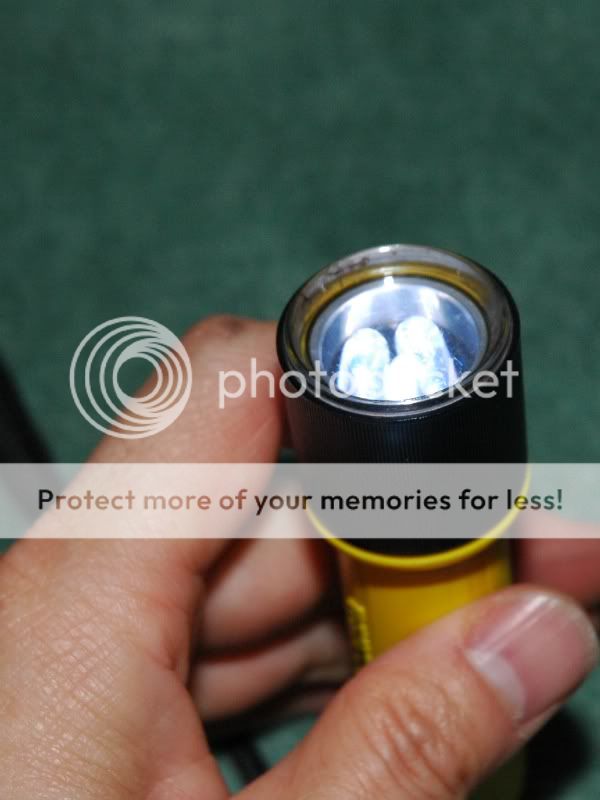PCC
Flashlight Enthusiast
Can anyone identify this light?
This is an old Tekna flashlight that I had bought back in the '80's. I put it into a Kershaw survival kit back in the day and forgot about it. Unfortunately, I forgot to take the battery out of it and it leaked all over the inside of it. By the time I found the light again the damage had been done: the reflector is gone, the metal eaten away. The plastic parts, though, are still in good shape so I decided to salvage it.

I wanted to get more run time from this light so I decided to convert it to LED, but what would I use? I tested the Nite-Ize 3-LED module at various voltages and found that it worked quite well even down to 0.7VDC. It draws about 200mA on 3VDC and less as the batteries drain down so it should offer fairly long run times on a single cell. Trying to fit it into the light was going to be a bit difficult, though, so I turned an aluminum plug to fit the Nite-Ize module and made it fit the Tekna. It fits the light just perfectly. Now I need a way to get the negative pole of the battery connected to this. I milled out a negative contact strap thing out of a piece of aluminum plate after I tried to order one from Tektite and it turned out to be the wrong one. I salvaged the spring from it and used it on the one I had made.

Here's a shot of the assembled module next to the original lamp assembly.


A shot of the battery with the strap installed.

A shot of the business end of the light with the Nite-Ize module ready to go.


Here it is next to my Quark MiNi AA on low for comparison. The MiNi AA on low puts out about the same amount of light as this one does on one cell. It's rated at 2.7 lumens on low so it's not all that bad.

It was assembled to be a personal flashlight to be used during emergencies so it doesn't need to be super bright. I had planned on using this light with a CR123a cell but the battery strap looks a bit thin even with the AA battery in place so I decided not to cut it any thinner to fit the CR123a cell. I'll just fit a Lithium AA battery in it or keep alkalines separately from it for those emergencies. I do live in earthquake country, after all.
This is an old Tekna flashlight that I had bought back in the '80's. I put it into a Kershaw survival kit back in the day and forgot about it. Unfortunately, I forgot to take the battery out of it and it leaked all over the inside of it. By the time I found the light again the damage had been done: the reflector is gone, the metal eaten away. The plastic parts, though, are still in good shape so I decided to salvage it.

I wanted to get more run time from this light so I decided to convert it to LED, but what would I use? I tested the Nite-Ize 3-LED module at various voltages and found that it worked quite well even down to 0.7VDC. It draws about 200mA on 3VDC and less as the batteries drain down so it should offer fairly long run times on a single cell. Trying to fit it into the light was going to be a bit difficult, though, so I turned an aluminum plug to fit the Nite-Ize module and made it fit the Tekna. It fits the light just perfectly. Now I need a way to get the negative pole of the battery connected to this. I milled out a negative contact strap thing out of a piece of aluminum plate after I tried to order one from Tektite and it turned out to be the wrong one. I salvaged the spring from it and used it on the one I had made.

Here's a shot of the assembled module next to the original lamp assembly.


A shot of the battery with the strap installed.

A shot of the business end of the light with the Nite-Ize module ready to go.


Here it is next to my Quark MiNi AA on low for comparison. The MiNi AA on low puts out about the same amount of light as this one does on one cell. It's rated at 2.7 lumens on low so it's not all that bad.

It was assembled to be a personal flashlight to be used during emergencies so it doesn't need to be super bright. I had planned on using this light with a CR123a cell but the battery strap looks a bit thin even with the AA battery in place so I decided not to cut it any thinner to fit the CR123a cell. I'll just fit a Lithium AA battery in it or keep alkalines separately from it for those emergencies. I do live in earthquake country, after all.



